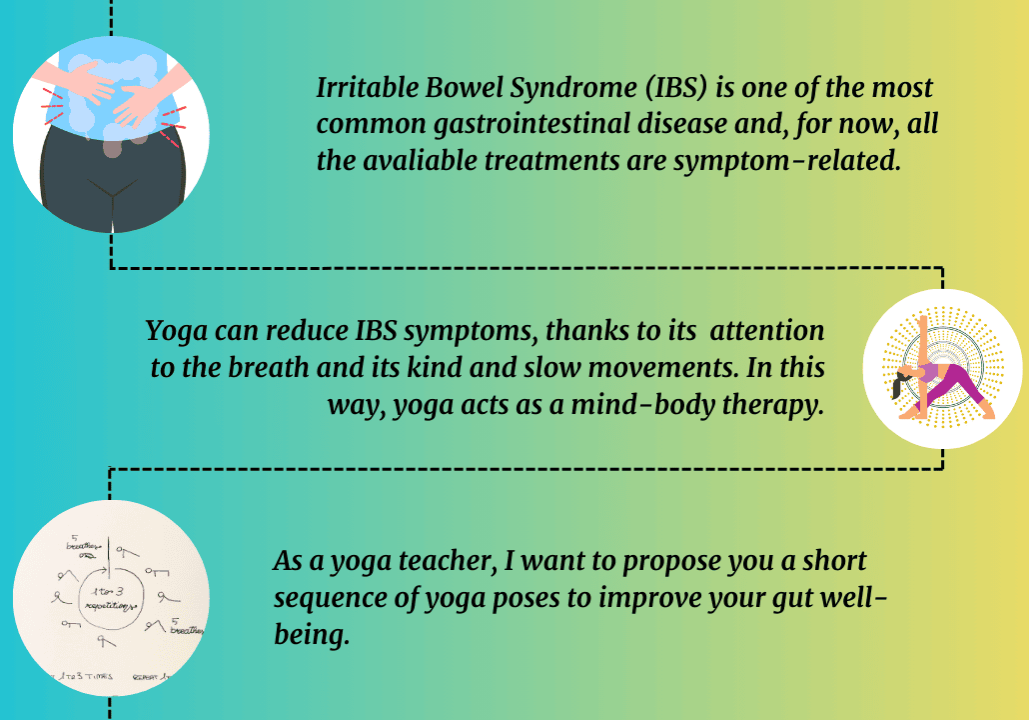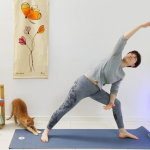
Yoga and Irritable Bowel Syndrome
A non pharmacological treatment to reduce IBS symptoms - By Serena Iannibelli
Reading time: 4 minutes
In this article we will talk about Irritable Bowel Syndrome (IBS) and the role of yoga as unconventional treatment for this common gastrointestinal disease. We'll also take a look on few asanas, yoga poses, that improve gut well-being.
- IBS at a glance: causes and symptoms
- Conventional treatments for IBS
- Yoga: a practice to reduce IBS symptoms
- 4 yoga poses to improve your gut well-being
- Conclusions
IBS at a glance: causes and symptoms
Irritable Bowel Syndrome is a common gastrointestinal disorder characterized by altered bowel habits, in association with abdominal discomfort or pain, in absence of detectable biochemical and structural abnormalities.
What are the causes behind this disorder that affects from 9% to 23% of the population across the world?
Unfortunately, the exact cause of IBS is still uncertain, but there are several factors involved:
- Infection and immune activation: bacterial gastroenteritis can lead to IBS and it may be due to the production of pro-inflammatory molecules and the disruption of normal gut flora;
- Serotonine dysregulation: serotonin plays a significant role in the control of gastrointestinal motility, for this reason, changes in its concentration determine alterations in peristalsis. In fact, the level of serotonin is decreased in patients with constipation (IBS-C) whereas is increased in patients with diarrhea (IBS-D);
- Small intestinal bacterial overgrowth that is frequently present in people with IBS;
- Psychological disturbances, such as stress, that dysregulate the gut-brain axis, leading to the production of pro-inflammatory molecules.
As told before, there are different types of IBS:
- IBS-C: characterized by constipation;
- IBS-D: characterized by diarrhea;
- IBS-M: characterized by alternating of constipation and diarrhea.
Except for constipation and diarrhea, that are antipodes, the symptoms of the disorder are mainly gastrointestinal, but there are also non gastrointestinal manifestations:
Abdominal pain or discomfort;
- Bloating;
- Diarrhea and/or constipation;
- Fatigue;
- Anxiety;
- Comorbidity with mood disorders.
Conventional treatments for IBS
Despite significant research efforts, unfortunately symptom-targeted treatments currently available for IBS do not guarantee definitive and lasting solutions, as they can offer minimum therapeutic improvements.
Treatment strategies for IBS may include both non pharmacologic and pharmacologic approaches:
- Lifestyle modifications, such as improving exercise, sleep, diet, and reducing stress are sometimes recommended;
- IBS-D patients can be treated with antidiaroic loperamide, antispasmodic agents, antidepressants, the gut-specific antibiotic rifaximin and probiotics (although their usefulness is still under consideration);
- For IBS-C patients, therapeutic strategies may include dietary fiber, laxatives and pro-secretory agents.
Yoga: a practice to reduce IBS symptoms
As told before, IBS symptoms are related to altered stress response from psychological and physiological mechanism and altered signaling from the gut-brain axis. For this reason, therapies focusing on mind-body interaction and stress reduction, such as yoga, can be complementary treatments for IBS.
There is accumulating of evidence and no risk of harm to support the use of yoga as therapy in managing the disease, therefore yoga is the complementary and alternative medicine preferred by the 77% of IBS patients.
Yoga has demonstrated its effectiveness in reducing IBS symptoms, anxiety and depression, while improving quality of life in patients, especially by reducing sympathetic activity (involved in the flight or fight response) and improving the parasympathetic activity (involved in relaxation mechanism).
4 yoga poses to improve your gut well-being
Let's see few examples of yoga poses that help bowel well-being. One of the peculiarity of this ancient discipline, is the slow and kind movement of the body that massages muscles and organs.
You can move through these poses as an extra-short practice and you can remain in each asana from 3 to 5 breaths.
Start in Tadasana, the mountain pose, and close your eyes. Stay here, feeling the breath moving trough your body, for 3 breaths. This is important to switch off your mind and start this short practice with a calm mood, in order to gain all the benefits of the following asanas.
- Utthita trikonasana (extended triangle pose): it stimulates and strengthens abdominal organs. To reach this pose, stand up, your right foot is facing to the right, and your left foot is behind you turned on 90°, your legs have the same shape of a triangle. Inhale and extend your arms on both sides, exhale and bend your torso on your right and to the ground, trying to touch your foot with your right hand. The left arm is facing to the sky. Repeat on the other side.
- Marjariasana-Bitilasana (cat-cow pose): it massages abdominal organs at the rhythm of the breath. It also stimulates abdominal organs. To reach this pose, go on your knees and on your hands, inhale and arch the spine, the eyes look to the sky, exhale and bow your back, the eyes look to the ground.
- Bhujangasana (cobra pose): it stimulates abdominal organs, improves digestion and reduces abdominal bloating. To reach this pose lie on your abdomen, keeping your legs straight on the ground. Put your hands near your chest. Inhale and turn and open your shoulders, in order to lift your chest. Your elbow are extended but not entirely.
- Jathara parivartanasana (lying spine twist pose): it improves blood circulation in the abdominal area. To reach this pose stay on your back, extend your arms on your sides, lift both your legs and bend your knees to 90°. Inhale and let your legs lie on your right, while your head is turning at your left. Exhale and change side: the head faces at your right and your legs are on your left.
Finish the practice in Savasana, the corpse pose, breathing slowly and deeply and stay here for all the time you need to.
Conclusions
IBS is a common bowel disorder that generates a significant health care burden and can severely impair quality of life and, since the reason of the disease is still uncertain, the conventional treatments are symptom-related and do not guarantee definitive solutions.
For this reason yoga, with its kind movements and the attention on breath, is a useful treatment that supports patients with IBS and that improves their quality of life.
In fact, there is accumulating evidence and no risk of harm to support the use of yoga* as a therapy in managing IBS, however, yoga is not included in clinical practice guideline for IBS.
References
Lekha S., 2014, Irritable bowel syndrome: pathogenesis, diagnosis, treatment and evidence-based medicine, World J Gastroenterol 2014, 20(22): 6759-6773;
Ng Q.X. et al., 2018, The role of infammation in Irritable Bowel Syndrome (IBS), Journal of Inflammation Research, 2018:11, 345-349;
Borghini R. et al., 2017, New Insights in IBS-like disorders: Pandora's box has opened; a review, Gastroenterol Hepatol Bed Bench 2017;10(2):79-89;
D'Silva A. et al., 2022, Meditation and Yoga for Irritable Bowel Syndrome: A Randomized Clinical Trial, Am J Gastroenterol 2023;118:329–337;
D'Silva A. et al., Gastroenterologist and Patient Attitudes Toward Yoga as a Therapy for Irritable Bowel Syndrome: An Application of the Theory of Planned Behaviour, Journal of the Canadian Association of Gastroenterology, 2023, 6, 17–25.
*commission earned from this link.







